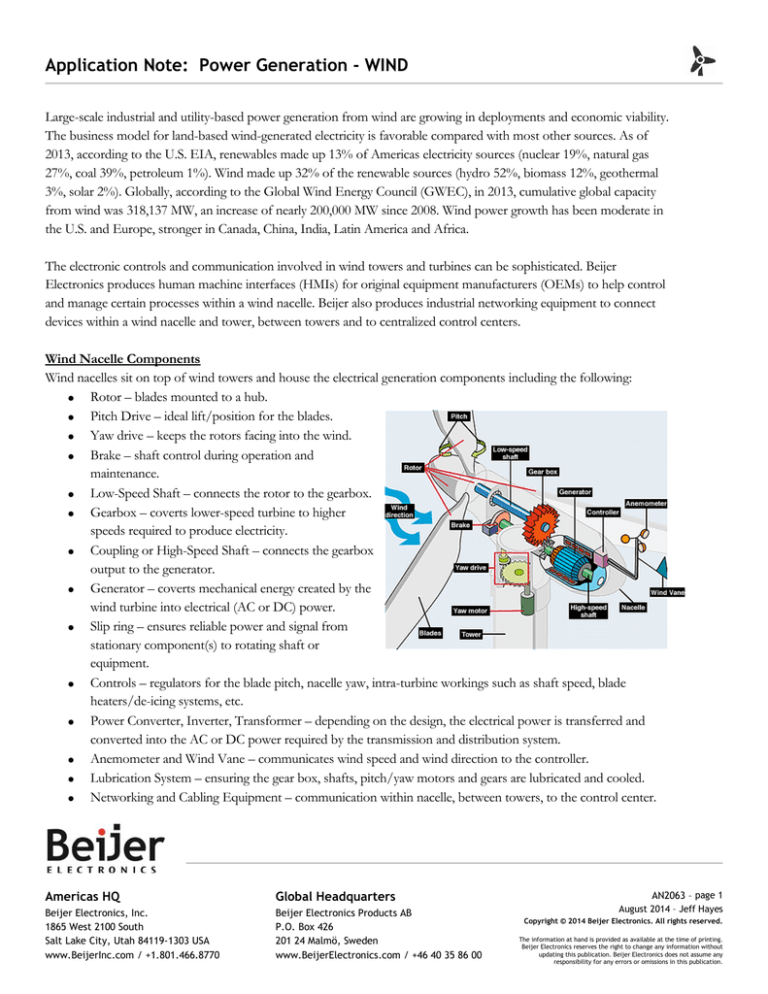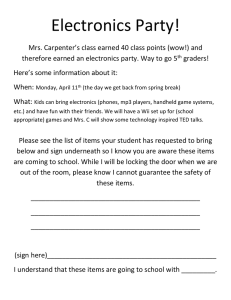
Application Note: Power Generation - WIND
Large-scale industrial and utility-based power generation from wind are growing in deployments and economic viability.
The business model for land-based wind-generated electricity is favorable compared with most other sources. As of
2013, according to the U.S. EIA, renewables made up 13% of Americas electricity sources (nuclear 19%, natural gas
27%, coal 39%, petroleum 1%). Wind made up 32% of the renewable sources (hydro 52%, biomass 12%, geothermal
3%, solar 2%). Globally, according to the Global Wind Energy Council (GWEC), in 2013, cumulative global capacity
from wind was 318,137 MW, an increase of nearly 200,000 MW since 2008. Wind power growth has been moderate in
the U.S. and Europe, stronger in Canada, China, India, Latin America and Africa.
The electronic controls and communication involved in wind towers and turbines can be sophisticated. Beijer
Electronics produces human machine interfaces (HMIs) for original equipment manufacturers (OEMs) to help control
and manage certain processes within a wind nacelle. Beijer also produces industrial networking equipment to connect
devices within a wind nacelle and tower, between towers and to centralized control centers.
Wind Nacelle Components
Wind nacelles sit on top of wind towers and house the electrical generation components including the following:
Rotor – blades mounted to a hub.
Pitch Drive – ideal lift/position for the blades.
Yaw drive – keeps the rotors facing into the wind.
Brake – shaft control during operation and
maintenance.
Low-Speed Shaft – connects the rotor to the gearbox.
Gearbox – coverts lower-speed turbine to higher
speeds required to produce electricity.
Coupling or High-Speed Shaft – connects the gearbox
output to the generator.
Generator – coverts mechanical energy created by the
wind turbine into electrical (AC or DC) power.
Slip ring – ensures reliable power and signal from
stationary component(s) to rotating shaft or
equipment.
Controls – regulators for the blade pitch, nacelle yaw, intra-turbine workings such as shaft speed, blade
heaters/de-icing systems, etc.
Power Converter, Inverter, Transformer – depending on the design, the electrical power is transferred and
converted into the AC or DC power required by the transmission and distribution system.
Anemometer and Wind Vane – communicates wind speed and wind direction to the controller.
Lubrication System – ensuring the gear box, shafts, pitch/yaw motors and gears are lubricated and cooled.
Networking and Cabling Equipment – communication within nacelle, between towers, to the control center.
Americas HQ
Global Headquarters
Beijer Electronics, Inc.
1865 West 2100 South
Salt Lake City, Utah 84119-1303 USA
www.BeijerInc.com / +1.801.466.8770
Beijer Electronics Products AB
P.O. Box 426
201 24 Malmö, Sweden
www.BeijerElectronics.com / +46 40 35 86 00
AN2063 – page 1
August 2014 – Jeff Hayes
Copyright © 2014 Beijer Electronics. All rights reserved.
The information at hand is provided as available at the time of printing.
Beijer Electronics reserves the right to change any information without
updating this publication. Beijer Electronics does not assume any
responsibility for any errors or omissions in this publication.
Application Note: Power Generation - WIND
Using Beijer HMIs in Wind Power Applications
HMIs provide the operator’s view and control of devices and equipment deployed within a wind nacelle. HMIs are used
by wind power OEMs to control blade pitch, nacelle yaw, inverters, speed, generator performance as well as relaying
information provided from sensors associated with wind speed and direction, temperatures inside/outside the nacelle
and of components such as the gearbox, rotor ice build-up, and fluid levels, flows and pressures.
Beijer’s iX HMIs are advanced operator terminals that provide remote access and control. The iX HMIs can be
configured to log events and activities. These logs can be pushed or pulled into standard formats for analysis, trending
and long-term storage. The alarm viewer provides real-time awareness of abnormal conditions. Maintenance workers can
view system and component manuals, videos and web pages for quick and accurate access to pertinent information.
Beijer’s iX operator terminals can be configured as a mini-SCADA system for the components within the wind nacelle.
The operator interface terminals provide the control, data repository, and drill-down capabilities for administrators and
technicians, whether they are physically within the wind tower or nacelle or connected remotely.
Wind Farm Development and Construction
Large-scale wind farm are costly in terms of time and capital. Wind energy development costs have decreased 90% since
the early 1980’s. Advancements in technology have reduced wind turbine costs, increased performance, streamlined
operations and maintenance, while advanced knowledge have enhanced engineering and construction abilities. The
following are some key players in the development, design, manufacturing, construction and purchase of wind power
that can benefit from understanding, specifying and deploying Beijer HMIs and associated componets:
Wind power developers: NextEra Energy, Great Southwestern Construction, Invenergy, E.ON, EDF
Renewable, RES Americas, First Wind, Terra-Gen Power, Midwest Wind Energy
Wind engineering firms: Tetra Tech, Black & Veatch, Burns & McDonnell, Fichtner, WSP, DNV GL, Ingham
Turbine OEMs: GE, Vestas, Siemens, Gamesa, Suzlon, Clipper Wind, Acciona, RE Power, Nordex
Windpower Constructors: Mortensen Construction, Barnhart, Iberdrola, IEA, Blattner Energy, Wind Energy
Constructors, Wanzek, Rosendin Electric, Signal Energy, Michels Corporation
Wind power purchasers: Xcel Energy, Southern California Edison, MidAmerican Wind, PacifiCorp, PG&E,
Alliant Energy, America Electric Power, CPS Energy, TXU Energy, Tennessee Valley Authority
Sources & References:
American Wind Energy Association - http://www.awea.org/
Global Wind Energy Council - http://www.gwec.net/
National Renewable Energy Laboratory - http://www.nrel.gov/ & http://www.nrel.gov/nwtc/
RenewableEnergyWorld.com - http://www.renewableenergyworld.com/rea/home/wind-power
U.S. Energy Information Administration - http://www.eia.gov/
Wikipedia Wind Power - http://en.wikipedia.org/wiki/Wind_power
Windpower Engineering & Development - http://www.windpowerengineering.com/
Americas HQ
Global Headquarters
Beijer Electronics, Inc.
1865 West 2100 South
Salt Lake City, Utah 84119-1303 USA
www.BeijerInc.com / +1.801.466.8770
Beijer Electronics Products AB
P.O. Box 426
201 24 Malmö, Sweden
www.BeijerElectronics.com / +46 40 35 86 00
AN2063 – page 2
August 2014 – Jeff Hayes
Copyright © 2014 Beijer Electronics. All rights reserved.
The information at hand is provided as available at the time of printing.
Beijer Electronics reserves the right to change any information without
updating this publication. Beijer Electronics does not assume any
responsibility for any errors or omissions in this publication.




